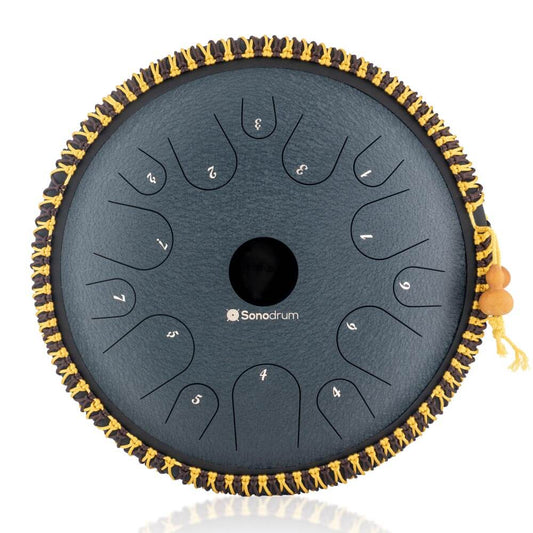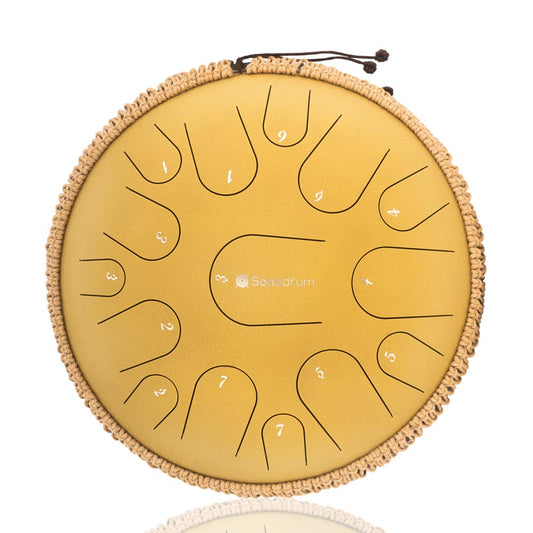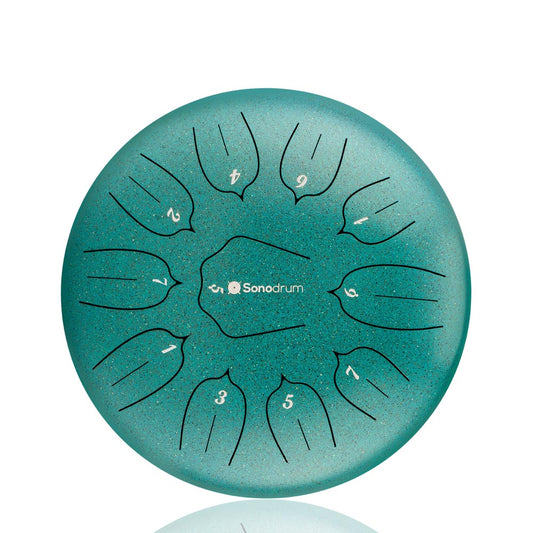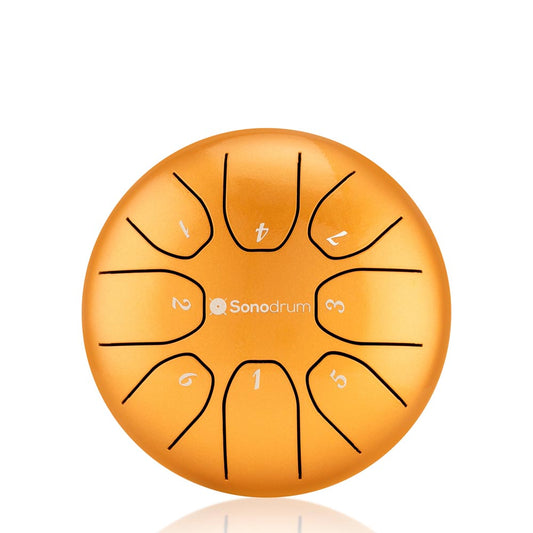As the practices of yoga and meditation continue to gain popularity, the use of sound healing instruments has also become a significant element in enhancing these experiences. Among the most favored instruments are the Tongue Drum and the Singing Bowl. This article embarks on an exploration of these two unique tools, prompting a thoughtful instrument comparison to understand how each contributes to a more profound meditative state. By delving into their distinct attributes and applications, readers can discover which instrument may be best suited for their personal yoga and meditation practices.
Key Takeaways
- The Tongue Drum and Singing Bowl both enhance meditation experiences.
- Each instrument offers unique sound qualities that affect emotional well-being.
- Consider personal preferences when choosing between the two for yoga practices.
- Sound healing plays a crucial role in deepening meditation and relaxation.
- Understanding the origins of each instrument can enhance appreciation and use.
Introduction to Sound Healing in Yoga and Meditation
Sound healing plays a vital role in enhancing both yoga and meditation practices. By utilizing various frequencies and vibrations, sound healing fosters an environment conducive to relaxation and self-discovery. Participants often experience profound shifts in their mental and emotional states, further enriching their journey toward wellness.
Understanding Sound Healing
Originating from ancient traditions, sound healing employs different sound instruments and techniques to promote healing on physical and emotional levels. Instruments such as singing bowls and tongue drums release vibrations that resonate with the body. This process allows for the release of tension and blocks, providing a pathway for energy to flow freely. Numerous studies substantiate the benefits of sound, including improved mood, reduced anxiety, and enhanced focus during meditation. These benefits empower individuals to delve deeper into their yoga and meditation sessions.
The Role of Music and Sound in Meditation
Music and sound serve as essential anchors for meditation, guiding practitioners to cultivate a focused mind. The rhythm and tones can significantly lessen distractions, making it easier to achieve a tranquil state. Using specific sounds during meditation enhances the experience by resonating with the body's natural frequencies. This alignment allows for deeper relaxation and transformation, unlocking further benefits of sound such as improved mental clarity and emotional balance.
What is a Tongue Drum?
The Tongue Drum is a fascinating instrument that has gained popularity in recent years due to its unique sound and accessibility. This melodic percussion instrument is known for its captivating tones, enchanting listeners during meditation and yoga sessions. Understanding the history, playing techniques, and benefits of the Tongue Drum enhances its appreciation and use in mindful practices.
History and Origin of the Tongue Drum
The history of the Tongue Drum traces back to ancient tribal cultures, where similar instruments were used in rituals and celebrations. These early forms often featured hollow logs or metal resonators with cut tongues, which created soothing sounds. As it evolved, the Tongue Drum incorporated various materials and designs, transforming it into the beloved modern instrument that players enjoy today.
How to Play the Tongue Drum
Learning the basics of playing the Tongue Drum can be a rewarding experience for beginners. The instrument is typically played by striking the tongues with mallets or fingers, allowing for a variety of rhythmic patterns. Popular playing techniques include simple strikes for calming melodies or more complex sequences that create a dynamic soundscape. Beginners can easily experiment with different notes and rhythms, inviting a sense of creativity and exploration.
Benefits of Using a Tongue Drum in Practice
The benefits of incorporating a Tongue Drum into meditation or yoga sessions are numerous. Its calming sounds enable relaxation, promoting mindfulness and emotional release. This instrument also facilitates a deeper connection to the present moment, enhancing the meditative experience. Many find that the vibrations of the Tongue Drum can help reduce stress and improve overall well-being.
What is a Singing Bowl?
The Singing Bowl, a fascinating tool used in meditation and healing, has captivated many with its rich history and beneficial properties. Its sound and vibrations help deepen relaxation and spiritual practices across various cultures. Let’s explore the history, usage, and meditation benefits of this remarkable instrument.
History and Origin of Singing Bowls
Singing Bowls originated in the Himalayan region, primarily found in Tibet and Nepal. These bowls were crafted from a unique alloy of metals, often thought to include copper, tin, and other elements, which contribute to their distinctive sound. Their use dates back centuries, where they played a crucial role in spiritual ceremonies and rituals, helping individuals attain higher states of consciousness. This rich history underlines the significance of the Singing Bowl in spiritual practices.
How to Use a Singing Bowl
Utilizing a Singing Bowl involves a few simple yet effective techniques. One can produce sound by striking the bowl gently with a mallet or by rubbing the rim with a wooden stick. The vibrations created resonate not only within the bowl but also in the surrounding space, promoting healing and calmness. Practitioners often incorporate the Singing Bowl into yoga sessions or meditation routines, enhancing their overall experience.
Benefits of Singing Bowls for Meditation
The usage of Singing Bowls offers numerous meditation benefits. These include:
- Stress reduction: The calming sounds help ease tension and anxiety.
- Mental clarity: The vibrations foster a clear mind, aiding in focus during meditation.
- Emotional balance: Regular practice can improve emotional health, creating a sense of peace and contentment.
- Deep relaxation: The soothing tones promote a profound state of relaxation, essential for effective meditation.
Integrating a Singing Bowl into one's meditation practice can enhance the overall experience, making it a valuable companion for anyone on a spiritual journey.
Tongue Drum vs. Singing Bowl: Which Is Better for Yoga & Meditation?
Both the Tongue Drum and the Singing Bowl serve as powerful meditation instruments, each boasting unique characteristics that can enhance practices in yoga and meditation. The Tongue Drum, known for its melodic tones and ease of play, often appeals to those seeking to create a soothing atmosphere with minimal effort. Its resonant sound can elevate the practice, promoting deep states of relaxation.
In contrast, the Singing Bowl offers a rich history and a broad range of tonal characteristics. Its profound vibrations have been recognized for centuries as tools for emotional healing and spiritual growth. Many practitioners appreciate its ability to harmonize personal energy and create a grounding experience during meditation.
The comparison between these two instruments can be subjective, often dependent on individual preferences. Some sound therapists emphasize that the versatility of the Tongue Drum allows for creative exploration within yoga classes, while others argue that the rich, resonant frequencies of the Singing Bowl provide a more profound depth in sound healing. Each instrument brings its unique set of benefits, facilitating different aspects of meditation practices.
| Feature | Tongue Drum | Singing Bowl |
|---|---|---|
| Sound Quality | Melodic, soothing tones | Rich, harmonic vibrations |
| Ease of Use | Simple to play | Requires technique |
| Emotional Impact | Promotes relaxation and focus | Facilitates deep emotional healing |
| Usage in Yoga | Enhances flow and movement | Grounds and centers energy |
Understanding how the Tongue Drum and Singing Bowl serve different purposes allows practitioners to choose the instrument that best aligns with their personal meditation and yoga journeys. Whether seeking melodies that uplift or vibrations that heal, both instruments hold remarkable potential for deepening one's practice.
Comparative Analysis of Sound and Vibration
Sound quality and vibration play crucial roles in the effectiveness of both the Tongue Drum and Singing Bowl. Each instrument produces distinct tones that greatly impact the overall experience of sound healing. Understanding these differences can enhance practices, such as yoga and meditation, allowing for deeper emotional connections and physiological responses.
Differences in Sound Quality
The sound quality of an instrument can influence emotional states and mental clarity. The Tongue Drum, known for its melodic tones, generates a warm, resonant quality. It often creates a calming environment, ideal for individual practice. In contrast, the Singing Bowl produces a range of frequencies that can evoke a more profound meditative state. The harmonic overtones resonate in a way that can penetrate deeply into the physical body, fostering a unique experience of sound healing.
Vibrational Effects on the Body and Mind
The effects on the body from different vibrations can vary significantly between these two instruments. Research indicates that low-frequency sounds, often produced by the Singing Bowl, can stimulate relaxation responses in the body. This vibration may lead to lowered stress levels and enhanced clarity of mind. Alternatively, the Tongue Drum's soothing melodies can initiate a gentle emotional release, fostering a healing atmosphere that resonates with bodily awareness.
| Instrument | Sound Quality | Vibrational Effects | Applications in Sound Healing |
|---|---|---|---|
| Tongue Drum | Warm, melodic tones | Gentle emotional release | Personal meditation, solo practice |
| Singing Bowl | Harmonic overtones | Deep relaxation response | Group sessions, restorative practices |
Choosing the Right Instrument for Your Practice
Selecting the most suitable instrument for yoga and meditation can significantly enhance one’s experience. Personal preferences and practice needs vary widely among individuals. This section aims to guide you through the factors to consider when choosing instruments that resonate with your spiritual journey.
Personal Preferences and Experiences
Each person's relationship with sound is unique. For many, the connection to an instrument can forge a deeper bond during meditation. Some practitioners find that the enchanting tones of a tongue drum allow for emotional release, while others may feel more at ease with the soothing vibrations of a singing bowl. These personal experiences highlight the importance of choosing instruments based on what feels right for you.
Factors to Consider: Space, Budget, and Sound
When determining which instrument suits your needs, practical aspects must not be overlooked. Consider your available space; a larger instrument might require a dedicated area, while smaller options may fit comfortably in various settings. Budget is another critical factor—both tongue drums and singing bowls come at various price points, allowing flexibility depending on your financial situation. Additionally, the sound quality plays a vital role; different instruments resonate distinctively within individual environments, which can affect the overall meditative experience.
| Instrument | Size | Price Range | Sound Quality |
|---|---|---|---|
| Tongue Drum | Medium to Large | $100 - $700 | Warm, melodic tones |
| Singing Bowl | Small to Medium | $30 - $500 | Rich, harmonic sounds |

Conclusion
In summary, both the Tongue Drum and the Singing Bowl offer distinct advantages for enhancing your yoga and meditation experience. Each of these instruments is deeply rooted in a rich history of sound healing, providing unique auditory landscapes that can help deepen your practice. The Tongue Drum produces soothing melodic tones that can elevate your mood and promote relaxation, while the Singing Bowl brings a harmonic resonance that has been cherished for centuries.
Ultimately, the choice between a Tongue Drum and a Singing Bowl hinges on personal preference, specific needs, and individual experiences. As you explore these musical tools, consider how each instrument resonates with you during your meditation practice. By incorporating sound healing into your routine, you may uncover new pathways to inner peace that significantly enhance your spiritual journey.
Whether you gravitate towards the enchanting sounds of the Tongue Drum or the tranquil vibrations of the Singing Bowl, embracing one or both of these instruments can lead to profound sound healing outcomes. So, embark on this musical exploration and allow your practice to flourish.
FAQ
What is the difference between a Tongue Drum and a Singing Bowl?
The Tongue Drum produces sound by striking its tuned tongues, creating a melodic and soothing tone. In contrast, a Singing Bowl generates sound by being struck or rubbed along its rim, producing a rich, resonant sound that can sustain longer vibrations. Both instruments serve as powerful tools for sound healing, but their unique sound qualities can evoke different emotional responses during yoga and meditation.
How do I choose between a Tongue Drum and a Singing Bowl for my practice?
Choosing between a Tongue Drum and a Singing Bowl depends on your personal preferences and meditation objectives. Consider factors like sound quality, vibrational effects, and the overall atmosphere you wish to create during your sessions. Additionally, assess practical aspects such as your available space, budget, and the specific sounds that resonate with you.
Can I use both a Tongue Drum and a Singing Bowl together?
Absolutely! Many practitioners find that using both a Tongue Drum and a Singing Bowl enhances their meditation experience. The interesting combination of their unique sounds can deepen your relaxation and mindfulness, providing a harmonious backdrop for your practice. Experimenting with both may help you discover new dimensions in your sound healing journey.
What are the health benefits of sound healing with these instruments?
Both the Tongue Drum and Singing Bowl offer various health benefits, including stress reduction, improved mental clarity, and emotional balance. Research indicates that sound therapy can help alleviate anxiety, promote relaxation, and even enhance overall well-being. By incorporating these instruments into your yoga and meditation practices, you may experience significant enhancements in your mental and physical health.
How do I properly maintain my Tongue Drum or Singing Bowl?
Maintaining your Tongue Drum and Singing Bowl is essential for preserving their sound quality. For the Tongue Drum, keep it dry and avoid exposing it to extreme temperatures; clean it occasionally with a soft microfiber cloth. For the Singing Bowl, use a soft sponge or cloth to clean the exterior and avoid using harsh chemicals. Proper care will ensure that you enjoy their beautiful sounds for years to come!




